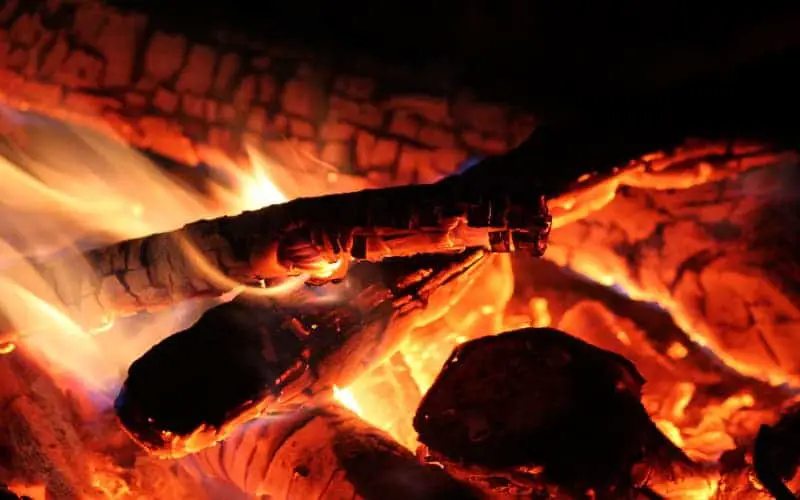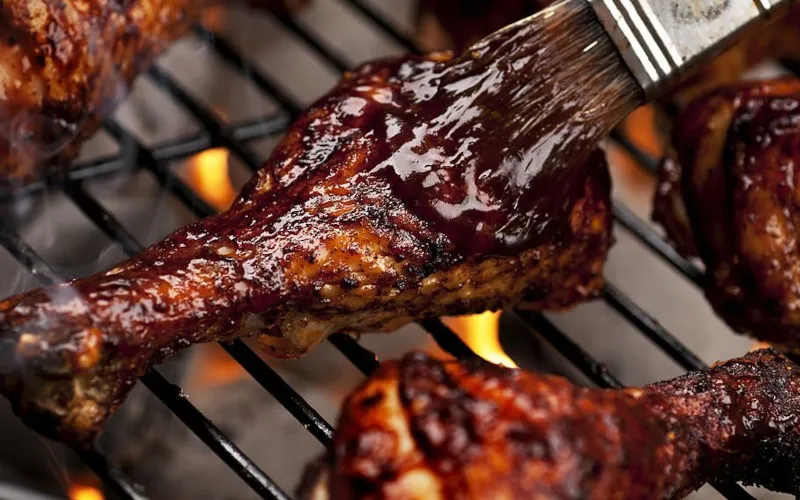For meat enthusiasts, many prefer their steak cooked to perfection with a juicy, pink center. However, some people like their steak blue – meaning very rare. While it may not look appetizing to some, blue steak is safe to eat as long as it is cooked properly.
It is said to be tastier and more tender than a steak cooked to a medium or well-done level.
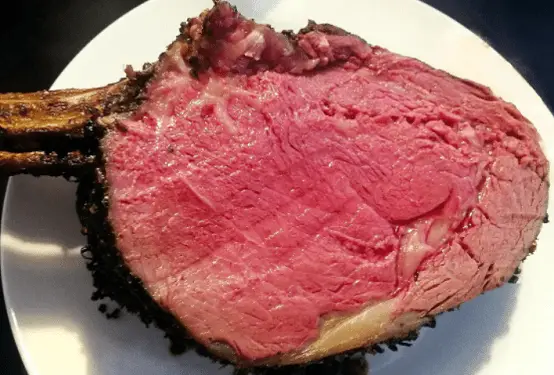
What is Blue Steak?
Blue steak is a type of steak that is red or pink in color. It’s often served rare or medium-rare and has a slightly sweet flavor. Blue steak is cooked quickly over high heat to create a crusty exterior and a juicy, flavorful interior. It’s best cooked on a grill, skillet, or broiler.
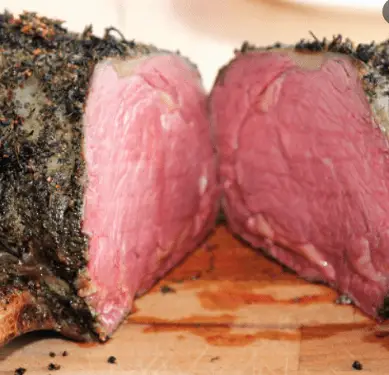
Why is it Called Blue Steak?
The term “blue steak” is used to describe meat that has been cooked very rare, or almost raw. The exterior of the meat may be browned or seared, but the interior is still pink or red. This type of steak is also sometimes referred to as “bloody” or “red.”
Some people prefer blue steak because they enjoy the taste of the meat when it is only slightly cooked. Others find that this type of steak is easier to digest than one that is cooked more thoroughly. However, there are also some risks associated with eating blue steak, as the meat may contain harmful bacteria that can cause food poisoning.
If you are interested in trying blue steak, it is important to make sure that the meat is from a reputable source and that it is cooked properly. You need to ensure that the exterior of the meat is browned or seared to kill any bacteria that may be present on the surface.
The interior of the steak should still be pink or red, and you should only cook it for a few minutes to ensure that it is safe to eat.
Is Blue Steak Safe to Eat?
Yes, blue steak is safe to eat. In fact, it is often considered to be more flavorful and tender than other types of steak. However, it is important to cook a blue steak properly in order to avoid any potential food safety issues.
When cooking blue steak, be sure to use a food thermometer to ensure that the meat reaches an internal temperature of at least 145 degrees Fahrenheit. This will help to kill any bacteria that may be present in the meat.
Additionally, it is important to let the steak rest for at least three minutes before cutting into it or consuming it, as this will help to further prevent the spread of bacteria.
What Cuts of Steak Can You Cook Blue?
You can try any cut of steak, but the results will not be the same. The best cuts of steak for cooking blue are those that are thin and have a lot of marbling.
These include:
- Filet mignon
- Sirloin tip
- Top sirloin
- Round steak
- Flat iron
All these cuts are best cooked quickly over high heat to maintain their tenderness, and to prevent them from drying out. If you want to try something a little different, you can also cook a blue steak using a reverse sear method.
This involves cooking the steak very slowly at first, until it is medium-rare, and then searing it over high heat to finish. This method can help to prevent the steak from drying out.
When cooking blue steak, it is important to remember that the meat will continue to cook after you remove it from the heat. This is called carryover cooking, and it can cause the steak to become overcooked if you are not careful.
For this reason, it is best to remove the steak from the heat when it is about 5 degrees lower than your desired final temperature. The steak will then continue to cook as it rests, and will reach the perfect temperature.
Which Cuts Should You Not Cook Blue?
For you to end with a beautiful blue steak, you need to start with the right cut of meat. Not all cuts of beef are ideal for cooking blue, so it’s important to know which ones to avoid. Here are four cuts of beef that you should not cook blue;
- Porterhouse/T-bone – It is one of the most popular cuts of steak, but it is not ideal for cooking blue. The reason for this is that the Porterhouse/T-bone has a large amount of fat running through it. This fat will render during cooking and make the steak greasy.
- Ribeye – Ribeye cannot be used for blue cooking because it is too thick. The thickness would cause the meat to overcook on the outside while the inside remains raw.
- Skirt steak – Skirt steak is another popular cut of beef, but it is not recommended for blue cooking. This is because the skirt steak is a very lean cut of meat and does not have enough fat to render during cooking. This will cause the steak to be tough and dry.
- Flank steak – Flank steak is a popular choice for blue cooking, but it can be difficult to get the right results. This cut of meat is very lean and has a tendency to overcook easily. If you are not careful, the flank steak will be tough and dry.
- Flap steak – Flap steak is a lean cut of beef that is not ideal for blue cooking. This cut of meat has a high amount of connective tissue, making it tough and chewy. If you must cook this cut of meat blue, be sure to do so quickly over high heat to prevent it from drying out.
- Hanger – It is a thin, long, and tough cut of steak that is attached to the cow’s diaphragm. It can’t result in good blue steak since it doesn’t have much fat.
- Bottom sirloin – It is a fairly tough cut of steak that is located near the rump of the cow. It has a fair amount of fat, but it is not ideal for blue cooking because it is tough and chewy.
What Does Blue Steak Taste Like?
Blue steak is often compared to rare steak in terms of taste. Both have a rich, beefy flavor that is slightly sweet. However, blue steak is less tender than rare steak and has a firmer texture. It is also often described as having a “gamey” flavor.
You may want to try blue steak if you enjoy rare steak but are looking for a more flavorful option.
Related: How to Tell If Your Steak is Bad?
Blue vs Rare Steak
Blue steak is a term used to describe meat that has been cooked very rare or raw. The outside of the steak will be browned or seared, but the inside will be red or pink. This type of steak is also known as “bleu” steak, ” Pittsburgh rare “, or “black and blue”.
Despite the name, blue steak is not actually blue. The term is derived from the French word “bleu” meaning blue or blue-colored.
The word “rare” is used to describe meat that has been cooked for a shorter amount of time than usual, resulting in a more tender and juicy steak.
Pittsburgh Rare vs Blue Rare
Pittsburgh rare is a type of steak that is usually served rare or medium rare. It is a cut of beef that is taken from the loin, and it is considered to be one of the tastiest and most tender cuts of beef. A blue rare, on the other hand, is a steak that is cooked very rare, and it is usually served with a blue cheese sauce.
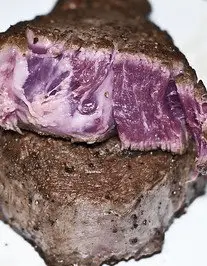
The difference between the two types of steak lies in the way they are cooked. Pittsburgh rare steak is usually cooked with high heat for a shorter period of time, while blue rare steak is cooked with low heat of under 120°F for a short period while it is cold.
This results in the Pittsburgh rare steak being more juicy and tender, while the blue rare steak is more flavorful.
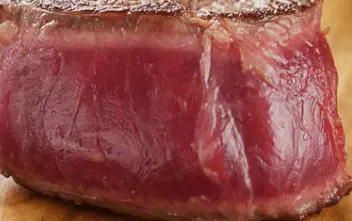
The charring of the meat also plays a role in the taste of the steak. Pittsburgh rare steak is usually char-grilled, while blue rare steak is pan-seared. This gives the Pittsburgh rare steak a smoky flavor, while the blue rare steak has a more buttery flavor.
Benefits Of Eating Blue Steak
Eating blue steak has a number of benefits. They include:
- Protein – Blue steak is a great source of protein. Protein is essential for muscle growth and repair, making it an important part of any diet.
- Iron – Blue steak is also a good source of iron. Iron is essential for carrying oxygen around the body and is important for maintaining energy levels.
- B vitamins – Blue steak is a good source of B vitamins. These vitamins are important for the metabolism of carbohydrates, fats, and proteins.
- Selenium – Blue steak is a good source of selenium. Selenium is an important mineral for the immune system and thyroid function.
- Zinc – Blue steak is also a good source of zinc. Zinc is important for immune function, wound healing, and fertility.
- Omega-3 fatty acids – Blue steak is a good source of omega-3 fatty acids. These essential fats are important for brain and heart health.
Eating blue steak is a great way to get all of these important nutrients into your diet. So if you’re looking for a healthy and delicious way to get more protein, iron, and B vitamins into your diet, blue steak is a great option.
How To Cook Blue Steak?
Cooking blue steak needs someone to follow a process and have the necessary ingredients to do so. The process is not difficult, but it requires precision and attention in order to cook the steak perfectly.
The following are the major steps to cooking blue steak:
1. What you are required:
- Olive oil
- Salt, Pepper, or your choice seasoning
- 1 pound of blue steak
- Grill tongs
- A meat thermometer
- Disinfecting wipes
2. The process of cooking the blue steak:
- Take your blue steak out of the fridge and let it come to room temperature. This will help ensure that the steak cooks evenly.
- Preheat your grill to high heat.
- Clean your grill grates with disinfecting wipes before cooking.
- Drizzle olive oil on both sides of the steak and season with salt, pepper, and your choice of seasoning.
- Place the steak on the grill and cook for 2-3 minutes per side.
- Use a meat thermometer to check the internal temperature of the steak. The steak is considered done when it reaches an internal temperature of 145 degrees Fahrenheit.
- Remove the steak from the grill and let it rest for 5 minutes before cutting into it.
Frequently Asked Questions
Can Blue Steak Give You Salmonella?
While it is true that blue steak can sometimes harbor salmonella bacteria, this is not necessarily indicative of poor meat quality. In fact, any type of meat can become contaminated with salmonella if it is not properly handled or cooked.
The best way to avoid getting sick from salmonella is to cook meat thoroughly and to avoid cross-contamination with other food items. If you have any concerns about the safety of blue steak, it is best to consult with a qualified food safety expert.
Can You Get Sick From Eating Raw Blue Steak?
Yes, it is possible to get sick from eating raw blue steak. This is because raw meat can contain harmful bacteria that can cause food poisoning. Symptoms of food poisoning include nausea, vomiting, and diarrhea.
If you experience these symptoms after eating raw blue steak, it is important to seek medical attention immediately.
Is Blue Steak Good?
Yes, blue steak can be good. It all depends on how it is cooked. If it is overcooked, it can be dry and tough. But if it is cooked properly, it can be juicy and delicious. The key is to not overcook it.
How Do You Cook Blue Steak?
The best way to cook a blue steak is to sear it in a hot pan. This will create a crust on the outside of the steak while keeping the inside nice and rare. Blue steak is best served with a simple salad or some roasted vegetables.
How Long Does It Take To Cook A Steak Blue?
It only takes a few minutes to cook a steak blue. Simply preheat your pan on high heat and cook the steak for 1-2 minutes per side. Steak blue is best enjoyed rare or medium-rare, so don’t overcook it! Enjoy your delicious steak blue with your favorite sides and sauces.
Is Blue Steak Cold In The Middle?
Yes, blue steak is often cold in the middle. This is because the steak is cooked very quickly on the outside, but the inside remains raw. If you are looking for a steak that is cooked all the way through, you may want to try a different cooking method.
What Is a Good Side Dish For Blue Steak?
There are many delicious side dishes that go well with blue steak. Some of our favorites include roasted potatoes, sautéed vegetables, and a simple green salad. Whatever you choose, make sure it complements the flavors of the steak and doesn’t overpower it.
With such a simple main dish, you have the opportunity to really showcase some amazing sides. So get creative and have fun with it!
Why Do People Order Blue Steak?
Some people might order blue steak because they think it will be more tender than another steak that is cooked well-done. Others might order it because they like the way it looks. And still, others might order it because they’ve heard that blue steak is a healthier option.
No matter the reason, there’s no denying that blue steak is becoming a more popular choice at restaurants.
Is Blue The Same As Rare?
No, blue is not the same as rare. Blue is a color, while rare typically refers to something that is not common. However, there can be overlap in some cases, such as with blue diamonds, which are quite rare.
Conclusion
While the blue steak’s color may be off-putting at first, it is perfectly safe to eat. It has the same nutritional value as any other steak. Using the correct methods while cooking the blue steak will lead to a perfectly cooked, juicy, and flavorful steak.
Whether you’re a beginner or an experienced chef, don’t be afraid to experiment with this unique cut of meat.

